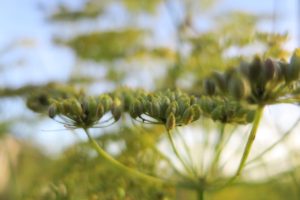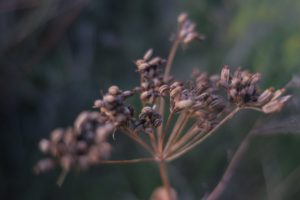Making Chinese Medicine Series 03
小茴香
Fennel (Foeniculum vulgare)
[excerpt from The Compendium of Materia Medica本草纲目 by Li Shizhen李時珍]

The following post was sparked by the wide-spread presence of wild fennel growing in my garden with thick stalks to a height of up to 2.5 metres. It has been utilized by me as flavouring for cooking noodles, stir-fries and recently seeds for tea. The latter had not even crossed my mind as green tea is my preferred choice, until I observed the drying of the seeds and subsequent storing for seasoning. I also found out that identifying the plant it was often mistaken as dill or anise, a point that will come up in the second translation excerpt. The pill formula stated in the first section will be attempted practically by the end of next week.
时珍曰︰小茴香性平,理气开胃,夏月祛蝇辟臭,食料宜之。大茴香性热,多食伤目发疮,食料不宜过用。古方有去铃丸︰用茴香二两,连皮生姜四两,同入坩器内腌一伏时,慢火炒之,入盐一两,为末,糊丸梧子大。每服三、五十丸,空心盐酒下。此方本治脾胃虚弱病。茴香得盐则引入肾经,发出邪气。肾不受邪,病自不生也。亦治小肠疝气有效。
[Li] Shizhen: The nature of Xiao Hui Xiang [1] is neutral; it regulates qi and opens the stomach. In the summer months, it drives away flies and repels bad odours. It is appropriate [to be served] as foodstuff. [On the other hand], the nature of Da Hui Xiang [i.e. star anise] is hot. If eaten in excess, it will harm the eyes and bring forth skin ulcers; hence it is not appropriate to be used in excess as foodstuff. There is an ancient formula ‘Qu Ling Wan’: It utilizes two liang of Hui Xiang and four liang of Sheng Jiang with its skin intact. Pickle both [ingredients] in an earthenware for one day cycle, then dry-fry on low heat, add two liang of salt, grind into a powder, and paste it into pills in the size of Chinese parasol seeds. Each time, take thirty to fifty pills and ingest with salted alcohol on an empty stomach. This formula originally treats spleen and stomach disease of vacuity and weakness. By acquiring salt, Hui Xiang is then guided into the kidney channel, where it effuses and discharges evil qi. When the kidneys do not receive any evils, then naturally, one will not engender any disease on its own. It also effective in the treatment of shan qiof the small intestine.
____________
时珍曰︰茴香宿根,深冬生苗作丛,肥茎丝叶。五、六月开花,如蛇床花而色黄。结子大如麦粒,轻而有细棱,俗呼为大茴香,今惟以宁夏出者第一。其他处小者,谓之小茴香。
[Li] Shizhen said: In winter, the perennial root of Hui Xiang grows seedlings, which form into clusters. It has a fat stalk and silk-like leaves. In the fifth or sixth lunar month, its flowers blossom, which resemble the flowers of She Chuang, but yellow in colour. When it bears seeds, they are the size of wheat grains; it is light with a slender edge. It is customarily called Da Hui Xiang. Nowadays, what is produced in Ningxia is the number one [in quality]. For those that bear small [seeds] in other places, they are called Xiao Hui Xiang. [2]

[1] I.e. Fennel seed (Foeniculi Fructus). On a side note, the particular type of fennel with a swollen, bulb-like stem base that is used as a vegetable for cooking is called Florence fennel or finocchio.
[2] It should be noted that a smaller variety of anise seed here is sharing the same name as fennel seed in Chinese, which potentially could cause some confusion, as towards the correct identification of the plant.
Would you like to subscribe to our newsletter?
If you enjoyed reading this please consider supporting us!
When we started the Purple Cloud Institute, our aim was to make accessible educational material about traditional Chinese cultural practices. We strive to keep prices of our books as affordable as possible and the content we provide free of charge. However, there are many ongoing behind the scenes costs and the time taken to provide such content is considerable.
If you have enjoyed our offerings please consider donating and supporting us. The help will allow us to make time to bring you more in the way of book publications, podcasts and videos about tradition-based Daoist, Chinese medicine and martial arts and help keep these traditions alive.
Your assistance is greatly appreciated!
